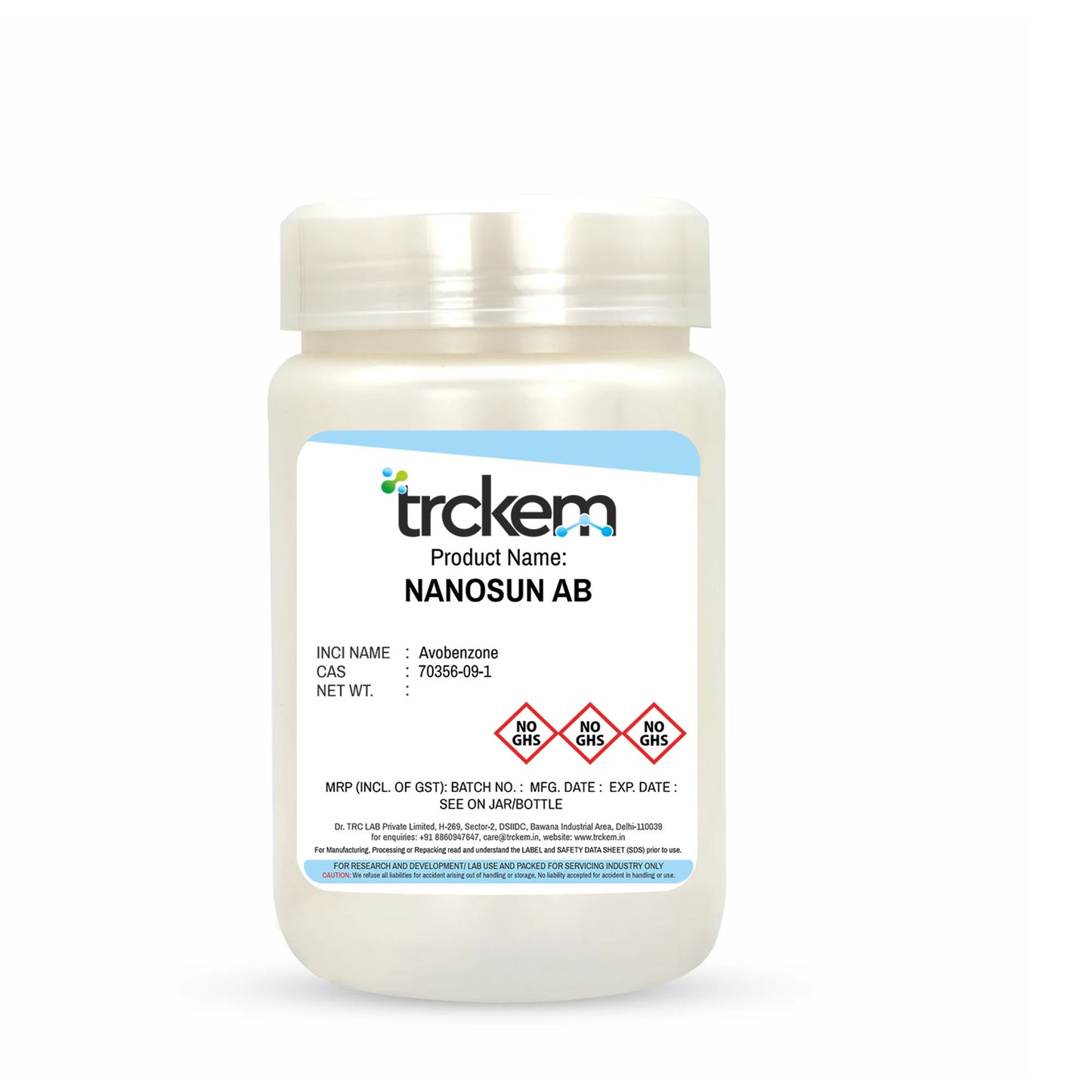

THE STORY OF NANOSUN AB

Nanosun AB: The Global Standard for UVA Protection
Nanosun AB (Butyl Methoxydibenzoylmethane) is a broad-spectrum organic UV filter widely used in sunscreens to provide high-efficiency protection against UVA rays (320–400 nm). It is one of the most trusted, globally approved sun-care actives for daily wear sunscreens, outdoor SPF, and anti-aging skincare.

High-Purity, Photoactive Molecule Engineered for UV Absorption
Nanosun AB is synthesized through a controlled multi-step organic reaction and purified to meet cosmetic-grade UV absorbance requirements. TRCkem supplies high-assay (≥98%) Avobenzone with validated UVA peak absorbance at 357 nm, suitable for global SPF formulations.

Long-Wave UVA Defense for Anti-Aging & Skin Health
Nanosun AB shields the skin from deep-penetrating UVA rays linked to premature aging, pigmentation, and long-term skin damage. Key benefits:
✅ Full UVA absorbance (including UVA-I range)
✅ Critical in broad-spectrum SPF systems
✅ Compatible with emulsion & anhydrous formats
✅ Essential for photo-aging prevention, anti-spot care, and daily SPF cosmetics
Often paired with UVB filters like Octocrylene or Zinc Oxide for full spectrum coverage.

Globally Approved, Requires Stabilization in Formulation
Typical use level:1–5%depending on SPF target & region.
Must be stabilized with compatible filters (e.g., Octocrylene, Encapsulated forms, Tinosorb S/M).
Oil-soluble; ideal for creams, sprays, sticks & daily SPF serums.
Approved for use in EU, Asia, LATAM; restricted up to3% in USA OTC SPF formulas.
Store away from heat & light to avoid photodegradation of raw material.
Formulator’s Queries, We Answered
1. What is NanoSun AB?
NanoSun AB is a nano-engineered version of Avobenzone (Butyl Methoxydibenzoylmethane), optimized for superior performance in sun care and personal care formulations. The nano format enhances stability, improves UV protection, and offers a lighter sensory profile.
2. What is Avobenzone and why is it widely used in sunscreens?
Avobenzone is an oil-soluble UVA filter renowned for its broad-spectrum protection. It effectively absorbs UVA rays, safeguarding skin from deep, long-wavelength UV damage in a range of formulations marketed as "broad spectrum" sunscreens
3. How does NanoSun AB differ from standard Avobenzone?
NanoSun AB retains Avobenzone’s UVA-blocking capabilities but is nano-sized to deliver:
Improved dispersion and uniformity
Enhanced photostability
Reduced risk of visible residue
Potential for higher SPF efficacy and smoother touch
Studies show that nanosystems can enhance sunscreen safety, UV protection, and cosmetic performance.
4. What are the key benefits of using NanoSun AB in formulations?
Better stability under UV exposure
Clean, lightweight texture with less greasiness
Enhanced skin feel due to finer particle size
Improved formulation clarity and SPF performance
Efficient UVA protection integrated seamlessly into modern UV care products
5. In which types of products is NanoSun AB most effective?
Ideal for:
High-performance sunscreens (SPF creams, gels, sprays)
Day moisturizers with UV protection
Facial serums with UV defense
Tinted moisturizers, foundations, and BB/CC creams with advanced UV filtering properties
6. What are the CAS Number and INCI Name of Avobenzone?
CAS Number: 70356-09-1
INCI Name: Butyl Methoxydibenzoylmethane (commonly listed as Avobenzone in ingredient lists)
NanoSun AB maintains the same INCI and CAS nomenclature for regulatory clarity, with its nano-character noted in technical documentation.
7. Is NanoSun AB safe for use in skincare and sunscreen formulations?
Yes. Avobenzone is globally approved for cosmetic and sunscreen use, typically up to 3–5% depending on region.The nano formulation does not compromise safety when properly stabilized and tested; rather, it may enhance photoprotection efficiency. However, formulators should ensure photostability through proper vehicle design and inclusion of stabilizers.
8. How should formulators incorporate NanoSun AB into their products?
Integrate during the oil phase or emulsification stage with gentle mixing
Pair with photostabilizers (e.g., octocrylene) to enhance stability under UV exposure
Thoroughly test for SPF performance, clarity, stability, and skin feel
9. Which skin types benefit most from NanoSun AB?
NanoSun AB is suitable for:
All skin types—including sensitive and oily skin—for its smooth, non-greasy finish
Dermatologically advanced UV protection needs
Everyday skincare routines requiring sleek formulation textures
10. Where can I source NanoSun AB and get formulation support?
NanoSun AB is available through our authorized distribution channels. We provide:
Sample quantities for product development
Technical datasheets and stability data
Bulk ordering options
Expert formulation guidance to help you integrate NanoSun AB into next-generation sun care and skincare lines




